英汉语言对比与翻译
英汉语言对比与翻译

“It is the meaning of a message that is transferred from one language to another, and the transfer is accomplished by analyzing and then reconstructing semantic relationships.”1 “Translation can therefore be defined as the operation by which the relevant signification of linguistic signs is determined through reference to a meaning as formulated in a message, which is then fully reconstructed in the signs of another language.”2 1、2. Delisle, J. Translation: An Interpretive Approach[M]. Eng. trans, by Logan. P & Creery. M., Ottawa: University of Ottawa Press, 1980: 3;52
翻译中英汉语言对比的重要意义 Nhomakorabea就保留原文句法与译文体现原作精神的问题,傅雷也有精辟的论述:“假如破坏本国文字的结构与特性,就能传达异国文字的特性而获得原作的精神,那么翻译真是太容易了。不幸那种理论非但是刻船求剑,而且结果是削足就履,两败俱伤。” 1
01
怒安. 傅雷谈翻译[M]. 沈阳:辽宁教育出版社2005:2
关于英汉语言的比喻
陈安定:英语句子好比“一串珍珠”,而汉语句子则像“一盘大小各异的珍珠,散落玉盘,闪闪发光,灿烂夺目。”1
英汉语言对比-术语翻译
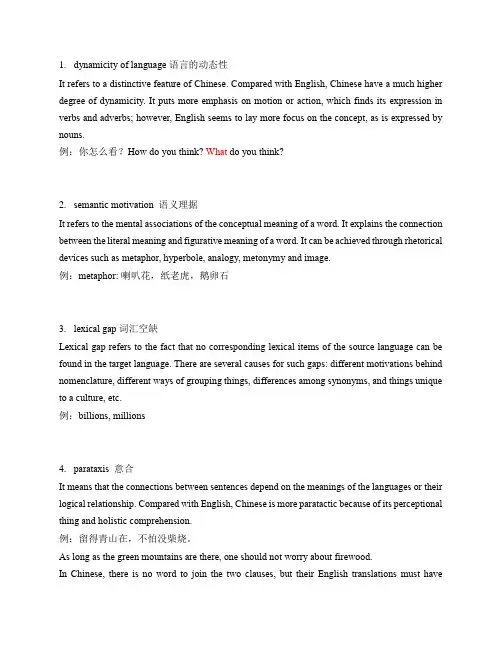
1.dynamicity of language 语言的动态性It refers to a distinctive feature of Chinese. Compared with English, Chinese have a much higher degree of dynamicity. It puts more emphasis on motion or action, which finds its expression in verbs and adverbs; however, English seems to lay more focus on the concept, as is expressed by nouns.例:你怎么看?How do you think? What do you think?2.semantic motivation 语义理据It refers to the mental associations of the conceptual meaning of a word. It explains the connection between the literal meaning and figurative meaning of a word. It can be achieved through rhetorical devices such as metaphor, hyperbole, analogy, metonymy and image.例:metaphor: 喇叭花,纸老虎,鹅卵石3.lexical gap 词汇空缺Lexical gap refers to the fact that no corresponding lexical items of the source language can be found in the target language. There are several causes for such gaps: different motivations behind nomenclature, different ways of grouping things, differences among synonyms, and things unique to a culture, etc.例:billions, millions4.parataxis 意合It means that the connections between sentences depend on the meanings of the languages or their logical relationship. Compared with English, Chinese is more paratactic because of its perceptional thing and holistic comprehension.例:留得青山在,不怕没柴烧。
英汉语言对比与翻译
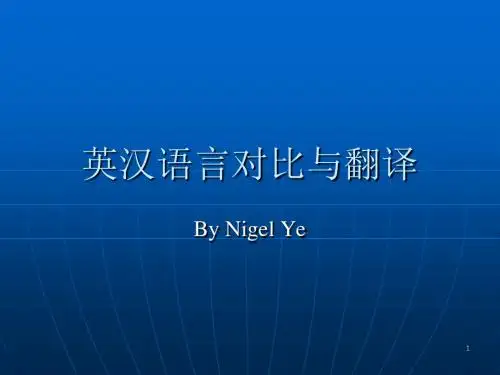
9
第二小点:‘有人就提前’
Unfortunately, the grey and blue cotton pieces reached us whereas our order was for a selection of the green and orange ones. 很遗憾,我们收到的棉制品是灰色的和蓝色的,而 我们订货时选的是绿色的和桔黄色的。 A fair comparison of quality between our products and similar articles from other sources will convince you of the reasonableness of our quotation. 贵方只要把我们的产品质量与别处的同类产品质量 比一比,就会知道我们的报价是合理的。
12
第五小点:抽象变火人
If understanding prevails, WTO is in a position to replace confrontation with agreement; it cannot be pull off. 如果大家能普遍接受的话,WTO就能用协议 取代对抗,而这项工作不能在拖延下去了。
10
第三小点:人多挑一个
Spectacular economic results ultimately won impressive staff support for the reformer manager. A.惊人的经济成果最终赢得了职工对这位改革派经 理的热情支持。 B. 到头来,职工们对这位改革派经理取得的惊人的 经济成果给予了热情的支持。 C. 这位改革派经理取得了惊人的经济成果,最终赢 得了职工们热情的支持。 D.这位改革派经理取得了惊人的经济成果,职工们 给予了热情的支持。
左彪-英汉对比与翻译(全)
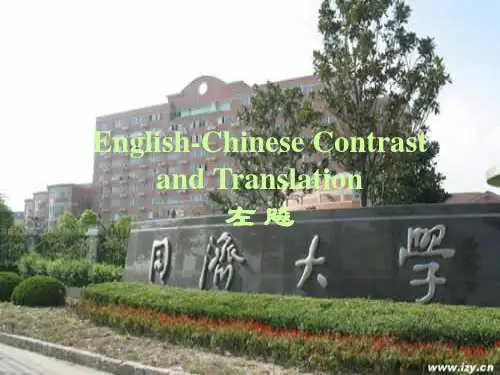
Two Types of Transfer
• Negative Transfer (负迁移) Errors arise from analogy. 类推会产生错误。 • Positive Transfer (正迁移) Errors decrease by analysis. 分析能减少错误。
We could turn negative transfer (interference) into positive (facilitation) by making analysis on differences between the two languages and arouse the learner‟s awareness of avoiding or reducing errors from analogy. 我们可以通过分析两种语言的差异,提高学生避免 或减少类推错误的意识,把负迁移(干扰)转化为正迁 移(促进)。
人在阵地在。 The position will not be given up so long as we are still living. 人无远虑, If one has no long-term considerations, 必有近忧。 he will find trouble at his doorstep.
English-Chinese Contrast and Translation 左飚
英 汉 对 比 与 翻 译
English-Chinese Contrast and Translation
左 飚
上海建桥学院 上海海事大学 zuobiao212@
欢迎光临
英 汉 对 比 与 翻 译
Chinese
Lacking inflection in the strict sense 缺少严格意义的 形态变化 老师们、同学们 我的爸爸、你的妈妈 认真的态度、 认真地学习
英汉语言系统对比与翻译
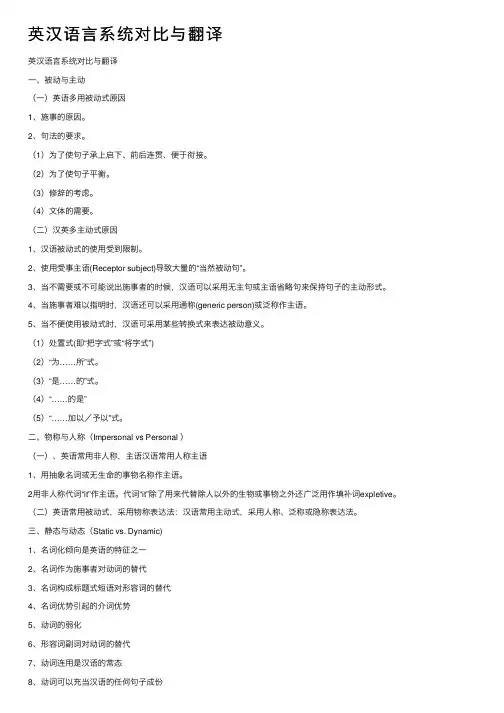
英汉语⾔系统对⽐与翻译英汉语⾔系统对⽐与翻译⼀、被动与主动(⼀)英语多⽤被动式原因1、施事的原因。
2、句法的要求。
(1)为了使句⼦承上启下、前后连贯、便于衔接。
(2)为了使句⼦平衡。
(3)修辞的考虑。
(4)⽂体的需要。
(⼆)汉英多主动式原因1、汉语被动式的使⽤受到限制。
2、使⽤受事主语(Receptor subject)导致⼤量的“当然被动句”。
3、当不需要或不可能说出施事者的时候,汉语可以采⽤⽆主句或主语省略句来保持句⼦的主动形式。
4、当施事者难以指明时,汉语还可以采⽤通称(generic person)或泛称作主语。
5、当不便使⽤被动式时,汉语可采⽤某些转换式来表达被动意义。
(1)处置式(即“把字式”或“将字式”)(2)“为……所”式。
(3)“是……的”式。
(4)“……的是”(5)“……加以/予以”式。
⼆、物称与⼈称(Impersonal vs Personal )(⼀)、英语常⽤⾮⼈称,主语汉语常⽤⼈称主语1、⽤抽象名词或⽆⽣命的事物名称作主语。
2⽤⾮⼈称代词“it”作主语。
代词“it”除了⽤来代替除⼈以外的⽣物或事物之外还⼴泛⽤作填补词expletive。
(⼆)英语常⽤被动式,采⽤物称表达法:汉语常⽤主动式,采⽤⼈称、泛称或隐称表达法。
三、静态与动态(Static vs. Dynamic)1、名词化倾向是英语的特征之⼀2、名词作为施事者对动词的替代3、名词构成标题式短语对形容词的替代4、名词优势引起的介词优势5、动词的弱化6、形容词副词对动词的替代7、动词连⽤是汉语的常态8、动词可以充当汉语的任何句⼦成份9、汉语句⼦中的动词可重复重叠⼀、被动与主动(Passive vs.Active) 被动语态在英语⾥是⼀种常见的语法现象。
在某些⽂体中,使⽤被动句⼏乎成了⼀种表达习惯。
Baker 指出:“被动句促成了物称倾向,物称倾向也滋长了被动句”。
(⼀)英语多⽤被动式原因1、施事的原因。
⼈们表达思想的时候,通常使⽤主动句。
04.英汉语言对比与翻译_讲义
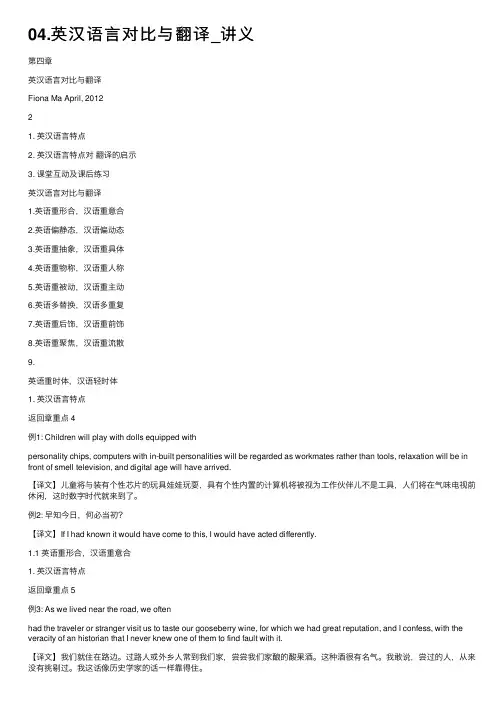
04.英汉语⾔对⽐与翻译_讲义第四章英汉语⾔对⽐与翻译Fiona Ma April, 201221. 英汉语⾔特点2. 英汉语⾔特点对翻译的启⽰3. 课堂互动及课后练习英汉语⾔对⽐与翻译1.英语重形合,汉语重意合2.英语偏静态,汉语偏动态3.英语重抽象,汉语重具体4.英语重物称,汉语重⼈称5.英语重被动,汉语重主动6.英语多替换,汉语多重复7.英语重后饰,汉语重前饰8.英语重聚焦,汉语重流散9.英语重时体,汉语轻时体1. 英汉语⾔特点返回章重点 4例1: Children will play with dolls equipped withpersonality chips, computers with in-built personalities will be regarded as workmates rather than tools, relaxation will be in front of smell television, and digital age will have arrived.【译⽂】⼉童将与装有个性芯⽚的玩具娃娃玩耍,具有个性内置的计算机将被视为⼯作伙伴⼉不是⼯具,⼈们将在⽓味电视前休闲,这时数字时代就来到了。
例2: 早知今⽇,何必当初?【译⽂】If I had known it would have come to this, I would have acted differently.1.1 英语重形合,汉语重意合1. 英汉语⾔特点返回章重点 5例3: As we lived near the road, we oftenhad the traveler or stranger visit us to taste our gooseberry wine, for which we had great reputation, and I confess, with the veracity of an historian that I never knew one of them to find fault with it.【译⽂】我们就住在路边。
实用英汉对比与翻译
第二章英汉句式结构对比与翻译一. 英文句式结构基本上为主谓结构,可以扩展为5种: 主+谓、主+谓+宾、主+谓+宾+宾补、主+谓+宾+间宾+直宾、主+系+表。
汉语中有部分句子与上述英文句子是对应的。
二. 中文句式结构(一)主谓结构。
(可分为主动和被动)(二)主题—评述句1. 很多汉语句子是“话题性”很强的句子,即句子的前面是一个话题,后面是对话题的评述或陈述、描述。
如:他处境很危险;楼上住着个女工。
2. 其中话题跟后面的动词只是对这个话题所作的说明,不一定表示主语所指称的实体的行动或性质,或者后面根本就没有动词。
3. 结论:将此类句子翻译成英文时,需进行句式结构的调整,在整个句中找到可以在英文中作主语的词,然后再根据主语选择合适的动词,如果找不到主语,就需要添加主语,或将句子中动作的承受着作主语,变为英文的被动语态。
4. 主题—评述句可归纳为如下几种:⑴动作承受者作话题。
如:那件事我已经办好了。
⑵双话题。
如:我头疼。
⑶动词或动词短语作话题。
如:加入世贸组织利大于弊。
⑷从句作话题。
如:张三明天去美国,我觉得很奇怪。
⑸地点作话题。
如:桌上搁着一碗饭。
⑹时间作话题。
如:今天风和日暖。
(三)无主句1.即“非主语句”,一种是没有主语的,叫无主句,还有一种是由一个词构成的,叫独词句,如:火!注意!这种句子可以直译。
2.一般来说,无主句主要用于以下几种情况:⑴表达客观、科学、公正的语气。
汉语的一些科技材料或法律条文中往往使用无主句,目的是使表达的内容更科学、公正。
这种情况下,无主句要以为英文的主谓结构时,一般都转化为被动语态,也就是使用原文的宾语做主语,因为被动语态不强调动作的发出者,可以比较准确地表达原文的语用效果。
如:要制造飞机,就要考虑空气阻力问题。
Air resistance has to be taken into consideration when an airplane is to be made.⑵表达不满又不失礼貌地语气。
《英汉语言对比与翻译》讲义6
《英汉语言对比与翻译》讲义翻译典型译例举隅:(1)形神兼备式七八个星天外,两三点雨山前。
(辛弃疾)Beyond the clouds seven or eight stars twinkle,Before the hills two or three raindrops sparkle.(2)舍形取神式Why the river is rich, because it has two banks.为什么河流是富有的,因为它总向前(钱)流。
(3)文字游戏人曾为僧;人弗能成佛,女卑为婢;女又何妨成奴。
A Buddhist cannot bud into a Buddha,A maiden may be made a home maid.(4)得形忘义抽刀断水水更流,举杯消愁愁更愁。
(李白)Drawing sword, cut into water, water again flows;Raising up, quench sorrow, sorrow again sorrow.(5)象形诗的翻译starIf you areA love compassionate,You will walk with us this year.HuddldAt your feet星啊,如果你那爱中满含怜悯,来年就和我们同行。
我们面对冰河距离,如今拥挤在你脚底(6)难译的原文石室诗士施氏,嗜狮,誓食十狮。
氏时适市视狮。
十时,适十狮适市。
氏视十狮,恃矢势,使十狮逝死。
氏拾是十狮尸,适石室,石室湿,氏使拭石室,石室拭,氏始试食是十狮尸。
食时,实识是狮尸,实十石狮尸,试释是事。
第一讲1、何谓翻译翻译,中国古代叫做“象寄”或“通事”《礼记·王制》。
严复在《天言论》的译例言中说:“海通以来,象寄之才,随地多有”。
《杨子·方言》中说:“译,传也。
”《说文解字》里说:“传译四夷之言者”。
汉明帝时,“摩腾始至,而译《四十二章》,因称译也。
英汉句子比较与翻译
01
傅雷:东方人与西方人的思维方式有基本分歧,我人重综合,重归纳,重暗示,重含蓄;西方人则重分析,细微曲折,挖掘唯恐不尽,描写唯恐不周。
汉语学家王力:西洋语法是硬的,没有弹性;中国语法是软的,富有弹性。……所以中国语法以达意为主。 英国人写文章往往化零为整,而中国人写文章却往往化整为零。
1
2
3
5
这个问题必须予以处理。
6
This matter must be dealt with.
7
无被动助词
1
看似主动,但在主谓关系上却有被动含义,这种语言现象在汉语中大量存在。
2
例句:
3
那里讲什么语言?
4
What language is spoken there?
5
这个任务必须按时完成。
6
This task must be fulfilled in time.
There is nothing wrong with this computer.
这台电脑没有什么毛病。
2 –ible, -able 结尾的形容词作定语,与every, the only或形容词最高级连用来修饰一个名词时,也常需后置。 The doctors have tried every way possible. 大夫们已经试过各种可能的办法了。 They had the greatest difficulty imaginable getting there in time. 为了能及时赶到那儿,他们克服了极大的困难。 It is the only wild berry edible here in this area. 它是这个地区惟一能食用的野莓。
I worked very hard on this book.
英汉语言对比与翻译教案
英汉语言对比与翻译教案一、教学目标1. 让学生了解英语和汉语在语音、语法、词汇、表达习惯等方面的差异。
2. 培养学生运用翻译技巧进行英汉互译的能力。
3. 提高学生对文化差异的敏感性,增强跨文化交际能力。
二、教学内容1. 英汉语言对比:语音、语法、词汇、表达习惯等方面的差异。
2. 翻译技巧:直译、意译、借译、归化等。
3. 文化差异:英汉文化背景、习俗、价值观等方面的差异。
三、教学方法1. 对比分析法:通过对比分析英汉两种语言的差异,让学生深入了解并掌握其特点。
2. 案例教学法:提供典型英汉互译案例,引导学生运用翻译技巧进行实践。
3. 讨论法:组织学生就文化差异展开讨论,提高他们的跨文化交际能力。
四、教学安排1. 英汉语音对比:4课时2. 英汉语法对比:4课时3. 英汉词汇对比:4课时4. 英汉表达习惯对比:4课时5. 翻译技巧讲解与实践:8课时6. 文化差异讨论:4课时五、教学评价1. 课堂参与度:观察学生在课堂上的发言和讨论情况,评估他们的学习积极性。
2. 翻译练习:布置英汉互译练习,评估学生的翻译能力和对翻译技巧的掌握程度。
六、教学活动与实例1. 英汉语音对比:通过播放英汉两种语言的语音样本,让学生识别并对比其差异。
例如,英语中的元音和辅音发音规则与汉语的声调特点对比。
2. 英汉语法对比:分析英汉两种语言的句子结构、时态、语态等方面的差异。
例如,英语的被动语态和汉语的无主句对比。
3. 英汉词汇对比:对比英汉两种语言中词汇的构成、词义差异和词性转换。
例如,英语的派生词和汉语的成语对比。
4. 英汉表达习惯对比:通过对比英汉两种语言在日常交流中的习惯用法,让学生了解并掌握其差异。
例如,英语的直接引语和汉语的间接引语对比。
七、翻译技巧训练1. 直译:在忠实原文的基础上,将英汉两种语言的词汇、语法结构等进行直接对应翻译。
例如,将英语的被动语态直接翻译为汉语的被动语态。
2. 意译:在忠实原文的基础上,根据汉语的表达习惯对英汉两种语言的词汇、语法结构等进行调整。
- 1、下载文档前请自行甄别文档内容的完整性,平台不提供额外的编辑、内容补充、找答案等附加服务。
- 2、"仅部分预览"的文档,不可在线预览部分如存在完整性等问题,可反馈申请退款(可完整预览的文档不适用该条件!)。
- 3、如文档侵犯您的权益,请联系客服反馈,我们会尽快为您处理(人工客服工作时间:9:00-18:30)。
If winter comes , can spring be far behind? 4. 好好学习,天天向上。
Study hard, and make progress eve. When I try to understand what it is that prevents so many Americans from being as happy as one might expect, it seems to me that there are two causes, of
2. The mountains began to throw their long blue shadows over the valley. 群山开始向山谷投下一道道蔚蓝色长影。
3. 李教授原打算在这干一辈子的,但还是由于种种原因去 了深圳。 Professor Li had planned to work here for the rest of his life, but now he has been to Shenzhen for reasons.
I also like righteousness. If I cannot have the
two together, I will give up my life to preserve
righteousness.”
hypotactic
Hypotactic vs. Paratactic
The American Heritage Dictionary defines
Feature of English as a hypotactic Language
Feature of Chinese as a paratactic Language
英语造句常用各种形式手 段连接词、语、分句或从 句,注重显性接应(overt cohesion),注重句子形 式,注重结构完整,注重 以形显义。
4.一群人立刻把他围住了,向他提出一个又一个问题。 Very soon he was surrounded by a crowd and was snowed under with questions.
Hypotactic vs. Paratactic 形合与意合
孟子曰:“鱼,我所欲也;熊掌,亦我所欲也。二者 不可得兼,舍鱼而取熊掌者也。生,我所欲也;义, 亦我所欲也。二者不可得兼,舍生而取义者也。”
1.He was struck by her powerful profile, her rich black hair falling freely onto her shoulders, the intensity of her dark eyes.
他一下子为她的出众长相所倾倒了:她一头乌发披肩,飘 逸潇洒,一双黑眸炯炯有神 。
谈判期间,各国的利益变化不定,好像万花筒似的,这就 使人难以分辨出究竟谁是“胜者”,谁是“输家”。
Subject prominent vs. Topic-prominent
主语显著与主题显著
汉语是一种“话题突出”的语言, 基本格式为”话题语+评论语“, 而英语是一种主语突出的语言,突 出的是句子的主语,而且两种语言 在表达形式上也相去甚远。
在不同的语言中,句子内部连接或外部 链接几乎都是用三种手段:
句法手段(syntactic devices)
词汇手段(lexical equivalence) 语义手段(semantic connection) 用前两种手段连接成为形合 (hypotaxis), 用后一种手段连接成为意 合(parataxis)。
which one goes much deeper than the other.
为什么如此众多的美国人不能如想象中那样幸福呢?我认
为原因有二,而两者之间又有深浅之分。 2. 抓住了主要矛盾,一切问题就可以迎刃而解。 Once the principal contradiction is grasped, all problems can be readily solved. 3.不进则退。 He who does not advance falls backward./ Move forward, or you’ll fall behind.
paratactic
Mencius said, “ I like fish and I also like
bear’s paws. If I cannot have the two
together, I will let the fish go and take the
bear’s paws. In a similar way, I like life, and
as “the arranging of clauses one after the other without connectives showing the
relation between them”, for example, The rain fell; the river flooded; the house washed away.
2.他们这群人,又想吃人,又是鬼鬼祟祟,想法子遮掩, 不敢直接下手,真要令我笑死。
All these people wanting to eat human flesh and at the same time stealthily trying to keep up appearances, not daring to act promptly, really made me nearly die of laughter.
Feature of Chinese as an Analytic Language
汉语基本没有形态变化,主要靠词语、词序及暗 含逻辑关系来表达句子的语言意义。
Practice
1.听到他这样讲话,我差点笑出来了。 I could have laughed to hear him talk like this.
analytic
Synthetic vs. Analytic
A synthetic language is “characterized by frequent and systematic use of inflected forms to express grammatical relationships.
Practice
1.玛丽没有被邀请去参加宴会,心里很难受。 Mary felt sad not to have been invited to the
banquet.
2.许多房子,盖着琉璃瓦,曲曲折折,无数的朱红栏杆。 Many houses were roofed with glazed tiles and set
汉语的主语不仅形式多样,而且可有可无。谓语也 复杂多样,可以是动词、名词或形容词可以是一个动 词,也可以是多个动词,还可以没动词;可以是一 个单词,也可以是多个词组。
汉语句式松散,句与句之间缺少连接成分,所表现 的信息往往从语法外形上主次不分,善用流水句, 常常把主要信息和次要信息的区别暗含在短句的并 列之中。
Feature of English as a Synthetic Language 英语通过词汇的形态变化,表示句子丰富多采的 语言关系和逻辑关系。
形态变化包括性(gender)、数(number)、格(case)、 时 (tense) 、 体 (aspect) 、 语 态 (voice) 、 语 气 (mood)、比较级(degree of comparison)、人称 (person)、词性(parts of speech)。
compact
男孩哭得心都快碎了,当我问及他时,他说饿极了,有 两天没吃了。
diffusive
Features of English as a Compact Language
句子主次分明,层次清楚,前呼后拥,严密规范, 句式呈“聚集型” (compactness)。
结构严谨,通常由名词性短语和动词性短语构成; 主语不可或缺,谓语动词是句子的中心,两者协 调一致提纲挈领,聚集各种关系网络。
英语句中的形合手段:关 系词和连接词、介词、其 他连接手段,广泛使用代 词 , 以 及 替 补 词 it 和 there 等等。
汉语造句少用甚至不用形 式连接手段,注重隐性连 贯 (covert coherence) , 注重逻辑事理顺序,注重 功能、意义,注重以神统 形。
汉语的意合法往往采用以 下手段:语序;反复、排 比、对偶、对照等;紧缩 句;四字格。
Synthetic vs. Analytic 综合与分析
They told me that by the end of the year they would have been working together for thirty years.
synthetic
他们告诉我,到(那年)年底,他们在一起工 作就有三十年了。
within winding red balustrades.
3.The kaleidoscope of shifting interests of the nations during the negotiation made it impossible to sort out the “winners” and “losers”.
英语句子先把主要信息以“主、谓、宾(表)” 的语法主干形式突出地表达出来,尔后再运用动 词不定式、分词短语、从句、独立结构或其他语 法手段来表现次要信息或用连词、介词来衔接。
Features of Chinese as a Diffusive Language
汉语主谓结构具有很大的多样性、复杂性和灵活性,因 而句式呈“流散型”(diffusiveness)。
